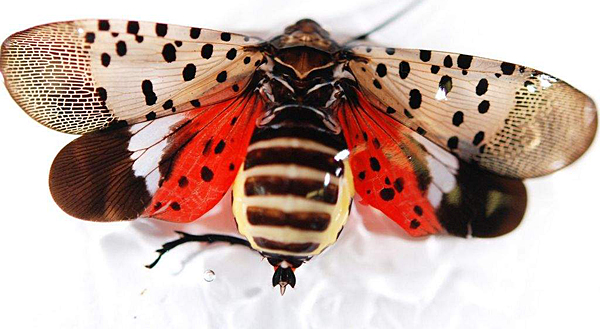Lycorma delicatula
The spotted lanternfly is an invasive planthopper recently introduced to the United States. It is native to China, India and Viet Nam. Spotted lanternflies feed on the sap of plants. High populations of Spotted Lanternflies can cause significant damage. They feed on many different host plants, including ornamental, forestry and agricultural crops.
Life Cycle:
The Spotted Lanternfly completes its life cycle in one year. They over winter in the egg stage. Beginning in late April to early May, nymphs hatch from their egg cases. Nymphs pass through four wingless instars. The first instar it is black. Later instars have red patches and white spots. Nymphs hop and crawl on plants as they feed. The adult spotted lanternfly is about 1 inch in length. They are very colorful. Their fore wings are greyish-brown with black spots. The color is especially noticeable when their wings are expanded. In July, adults begin to appear. They mate and the females lay eggs from late September until winter. The egg masses contain 30–50 eggs that are covered in a protective, yellowish brown waxy deposit. The spotted lanternfly lays eggs on smooth-trunked trees, stone, vehicles and many items that are stored outside. The egg masses can be spread long distances on infested material.
The damage:
Spotted Lanternfly causes damage to plants in two different ways. The nymphs and adults feed on plants using their piercing mouthparts to suck fluids from the stems or leaves. This can cause stunted growth, stress and reduced yields of agricultural crops. In extreme cases this can cause death to the plant. As the spotted lanternfly feeds, it excretes a sugary substance called honeydew. This honeydew attracts ants, wasps, and other insects. The honeydew also promotes the growth of sooty mold, that causes parts of the plant to become blackened, which can further damage the plant. The Spotted lanternfly feeding activity might spread disease from one tree to another.


